Desire and Power: Adam and Eve in Genesis 1–3
In all of God’s Creation, there is but one divinely acknowledged defect: “It is not good for man to be alone” (Gen. 2:18). So God creates woman. But could it be that in rectifying one flaw, God inadvertently introduces another? Might the creation of Eve give rise to a second problem even as it solves the first, a problem that then requires its own solution? Perhaps a fresh reading of Genesis 1–3 will help us answer this question.
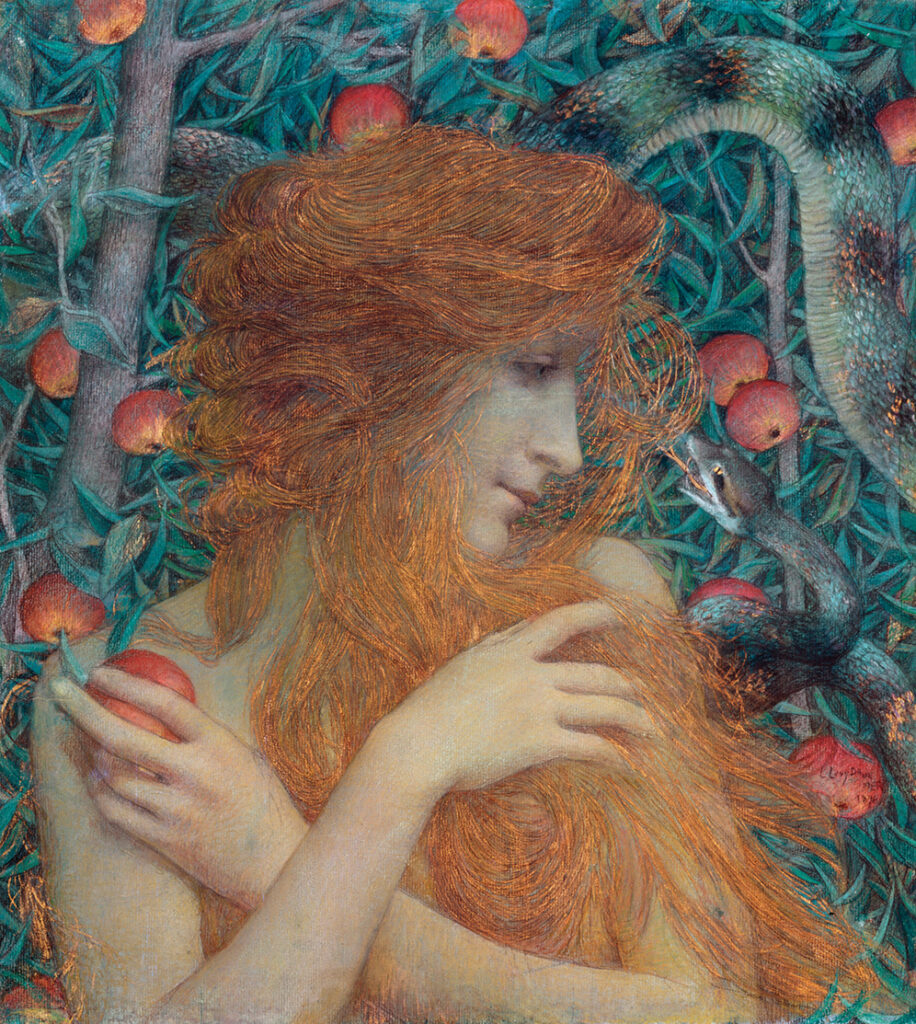
There are a variety of ways to address the glaring differences between Genesis 1 and 2; my fairly traditionalist approach is to read Chapter 2 as fleshing out the laconic account found in Genesis 1:27: “And God created man in His image, in the image of God He created him; male and female He created them.” As Chapter 2 tells it, at first there is only adam, only a man. Adam is intelligent. God entrusts him with naming all the animals—and places him in charge of the garden, “to till it and to tend it” (Gen. 2:15). But Adam lacks a human connection; there is no one who is his mate. None of the animals that God fashions will do. The only way Adam can be made whole, God realizes, is in union with another being like him, another member of his species. So God removes from Adam a part of his body, flesh is added to it to complete the new being, and breath is breathed into that new being: woman.
Biblical scholars disagree as to whether the word used for the part of the body from which the woman is created, tzela, means side or rib. If it is Adam’s side, that may imply that the human being was originally androgynous and was later split into two gendered halves. Rashi quotes, but does not explicitly endorse, a midrash that proposes this view, which, as has often been noted, seems to echo Aristophanes’s famous myth explaining the origin of love in Plato’s Symposium (189a–193e). My inclination is to favor rib and to read the Bible as telling a very different story.
First, the expression achat mitzalotav, “one of his tzela’ot,” suggests that there are many of them; hence, rib seems more likely. Second, in a Creation account replete with acts of division, why is there no talk here of God’s dividing Adam? Third, if the human being was originally androgynous, as the advocates of “side” suppose, why was Adam lonely? In Aristophanes’s myth, it is the splitting of the original self that leaves each half feeling bereft, a condition assuaged only when the two halves are reunited. But in Genesis, loneliness comes first. Moreover, although Genesis 1:27 is frequently cited as the textual basis for an androgynous Adam, it reads: “male and female He created them”—not him. The blessing subsequently bestowed on the couple, “Be fruitful and multiply” (Gen. 1:28), is also in the plural.
It appears, then, that in Genesis, the male and female were not originally conjoined as they are in Aristophanes’s myth. Nor are they equals. The common reading among both traditionalists and feminists is that the male is presented as superior, but does the text support this interpretation? It is, after all, the woman who lacks nothing; she even contains a part of the man. The man, by contrast, is now incomplete: a piece of his body has been removed. Furthermore, the woman was never alone; from the start she had a companion. She is introduced into the world to satisfy the neediness of another, but she herself is not needy. Adam is delighted at the sight of the woman when they are first introduced to one another. He exclaims: “This one at last is bone of my bones and flesh of my flesh” (Gen. 2:23). There is no comparable reaction on the part of the woman.
Perhaps an analogy, even an imperfect one, would be useful. Imagine parents blessed with a child. The child is at first perfect in their eyes, but they soon sense that the child is lonely. So they have another child—a girl, say, a sister to their firstborn. This solves one problem but creates another. Yes, the older child now has a sibling and so is no longer lonely, but he must now adjust to not being the only child. Since the younger child was never an only child, she was never lonely. Moreover, since she was never an only child, she does not have to adjust to not being one.
One way in which a dependent and needy person might seek to ensure the survival of the being on whom he depends is by becoming overprotective. We have good textual reason to think that this is precisely what Adam does. The prohibition regarding the tree of knowledge of good and evil—issued to Adam alone (Gen. 2:16–17) before the creation of the woman—forbade only one thing: eating of the fruit of that one tree (Gen. 2:17). Yet when the woman reports the prohibition to the serpent, she gets it wrong. Although she corrects the serpent when he describes the prohibition as extending to all the trees of the garden (Gen. 3:1), she says that it applies to the fruit of the tree in the center of the garden, rather than to that of one specific tree (whose name she doesn’t say and perhaps doesn’t know), and she adds that one may not touch it (Gen. 3:3). Where could the woman have gotten these ideas but from Adam? Apparently, he inflated the prohibition, to make doubly, or triply, sure that she wouldn’t sin. After all, he cannot afford to lose her.
The serpent now seizes his opportunity: He directs the woman’s lust toward the fruit. It is the fruit—not the man—that fulfills all her yearnings: “When the woman saw that the tree was good for eating and a delight to the eyes and that the tree was desirable as a source of wisdom, she took of its fruit and ate” (Gen. 3:6). All the trees of the garden were “pleasing to the sight and good for food” (Gen. 2:9), but the tree of knowledge of good and evil provided the woman not only with physical pleasure and aesthetic enjoyment but with intellectual fulfillment as well.
In the Genesis narrative, then, attraction is not at first a two-way street. The narrator bluntly states the asymmetry at the end of Chapter 2: “Hence a man [ish] leaves his father and his mother and clings to his woman [ishto], so that they become one flesh” (Gen. 2:24). Nothing similar is said of the woman. The unidirectional attraction from man to woman was the result of God’s attempt to rectify the first flaw in Creation, man’s loneliness, which was “not good.”
Nothing in the biblical text suggests that Adam desired the fruit and would have disobeyed God’s command on his own. Indeed, he does not disobey God until obeying God means disobeying the woman: “She took of its fruit and ate. She also gave some to her man with her [imma] and he ate” (Gen. 3:6): He eats the fruit because the woman gives it to him. The woman desires the fruit—and the man cleaves to the woman.
When the man’s and the woman’s eyes are opened and they see their nakedness and sew for themselves fig leaves and make for themselves girdles, they are as one: “The man and his woman hid from the Lord God amid the trees of the garden” (Gen. 3:8)—tellingly, the verb is masculine singular.
Yet God calls out to Adam alone; after all, it is Adam to whom He issued His command. “Where are you?” (ayekah), God asks. In responding, Adam protects the woman, indicting only himself: “I was afraid because I was naked so I hid” (Gen. 3:10). When God asks him if he ate from the prohibited tree, he answers that the woman God made to be with him had given him the fruit—and he ate (Gen. 3:12). Adam’s answer is the plain unembellished truth. He does not accuse the woman of seducing him. She didn’t—and she didn’t have to. Since she was “the woman You gave [to be] with me (immadi),” to be his companion—and not merely, as he might have said, “The woman You gave to me (li)”—when she gave him the forbidden food, he ate.
When God turns to the woman, asking, “What have you done?” she, like the man, states the facts: “The serpent beguiled me, and I ate” (Gen. 3:13). Her punishment is that she will experience pain in childbirth and now, only now, will she desire the man, who will rule over her (Gen. 3:16). After correcting the first flaw in Creation, the man’s loneliness, God finds that He must now correct a second, newly created, one: the power imbalance resulting from one-sided desire. So the woman will now also desire the man, who, as a consequence, will rule over her: she will bear his children despite the pain. Indeed, one might say that the man’s punishment—that he must now eke out sustenance from recalcitrant soil—compounds the woman’s: if he must work hard, he will necessarily have things on his mind other than his desire for her. Adam now renames his woman Havah, or Eve, “mother of all the living” (Gen. 3:20). As the new name indicates, the woman is no longer to him “bone of my bone and flesh of my flesh,” isha to his ish; she is no longer first and foremost his helpmate. Eve is instead the one who gives life.
God corrects the first flaw in Creation—the loneliness of the man—by creating the woman. But the creation of woman gives rise to a second flaw: the man becomes so attached to the woman that he obeys her rather than God. This, too, must be rectified, and so God levels the playing field of desire.
Although God’s pronouncement that “your passion shall be for your husband, and he will rule over you” (Gen. 3:16) has been taken as a biblical justification—perhaps even as a mandate—for the patriarchal subjugation of wives to their husbands, this interpretation comes to the story too late, taking the verse out of its narrative context. The man desires the woman first, before she comes to desire him. And his ruling over her comes second, after she rules him (when she gives him the fruit, he eats it—even if it means disobeying his creator). Nor does the man’s desire for the woman cease just because she now desires him too. Her power over him remains intact even as he “rules” her.
Many changes occur over the course of this brief narrative. The man who was once alone finds a companion and helper. Sin enters Creation as the woman yields to the serpent’s seduction. Childbirth and work become difficult. The man gives the woman a new name. And the human race becomes subject to mortality. But surely one of the most significant changes is that the woman who is desired by the man is made to return that desire, thus ceding to him some measure of power over her.
The deceptively simple narrative of Genesis 1–3 tells a complex tale of desire and power-relations between the sexes. Far from a call to patriarchy, the story of Adam and Eve portends the fraught partnership of equals, which can as easily end in failure as in success.
Comments
You must log in to comment Log In
Suggested Reading
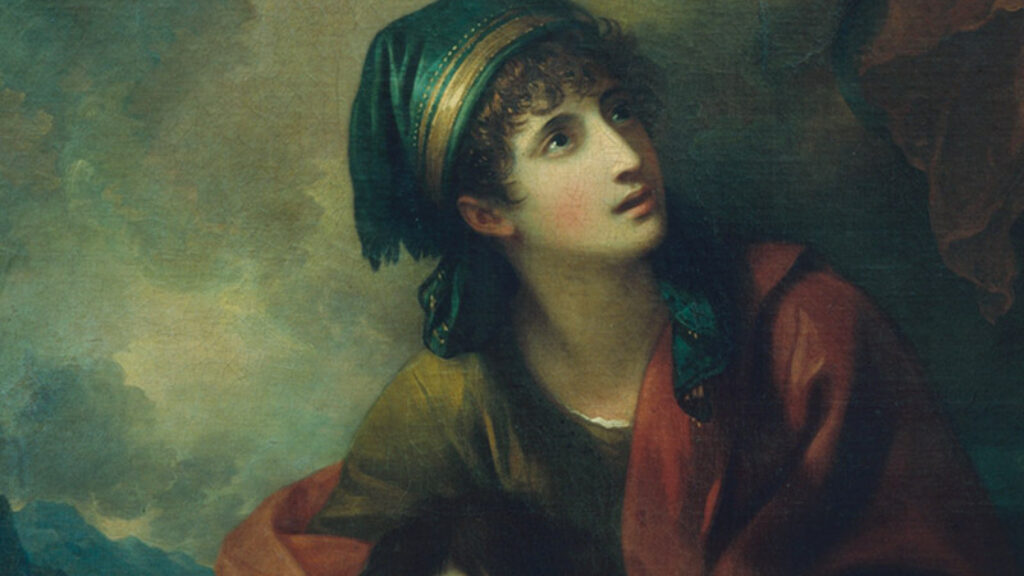
“The One You Love”? A Case of Divine Disappointment
Which son did Abraham favor? Reading "the binding of Isaac" with fresh eyes.
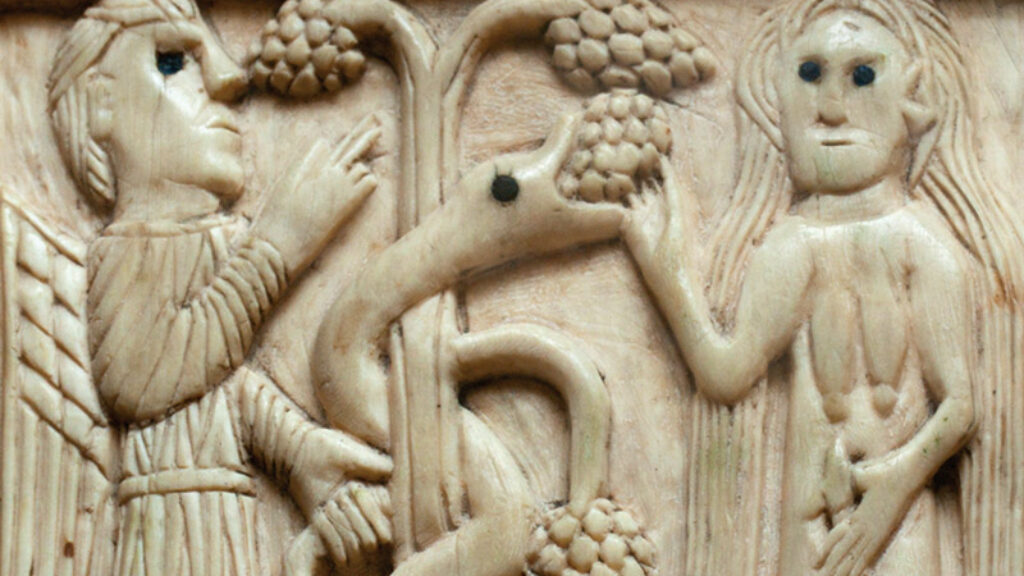
Fruit of the Fall
The forbidden fruit has been said to be anything from a fig to a banana, so how did the world settle on an apple?
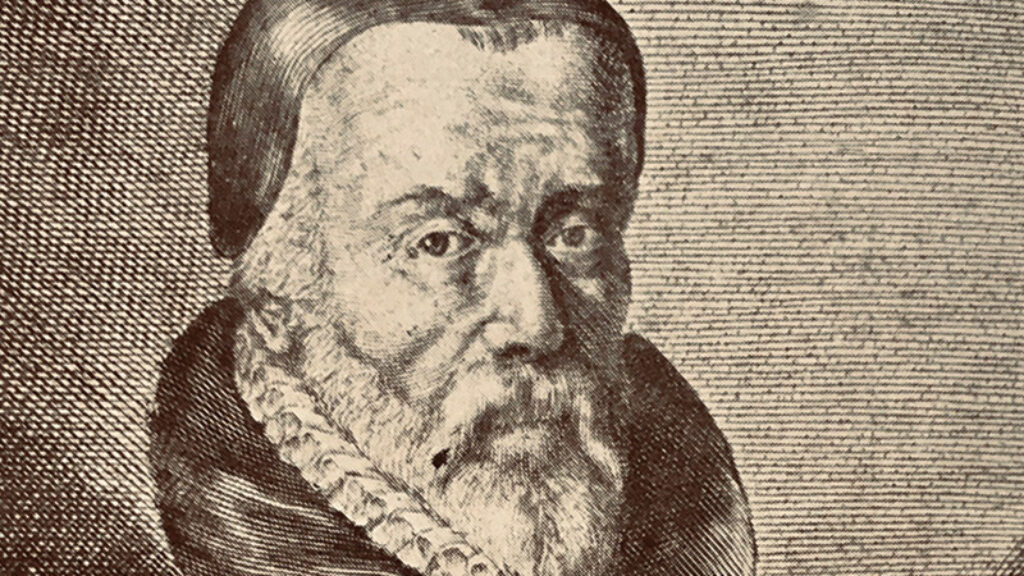
From King James to Koren
The new Koren Tanakh smoothly addresses some thorny questions of biblical translation, including this one: Are there dolphins in the Torah?
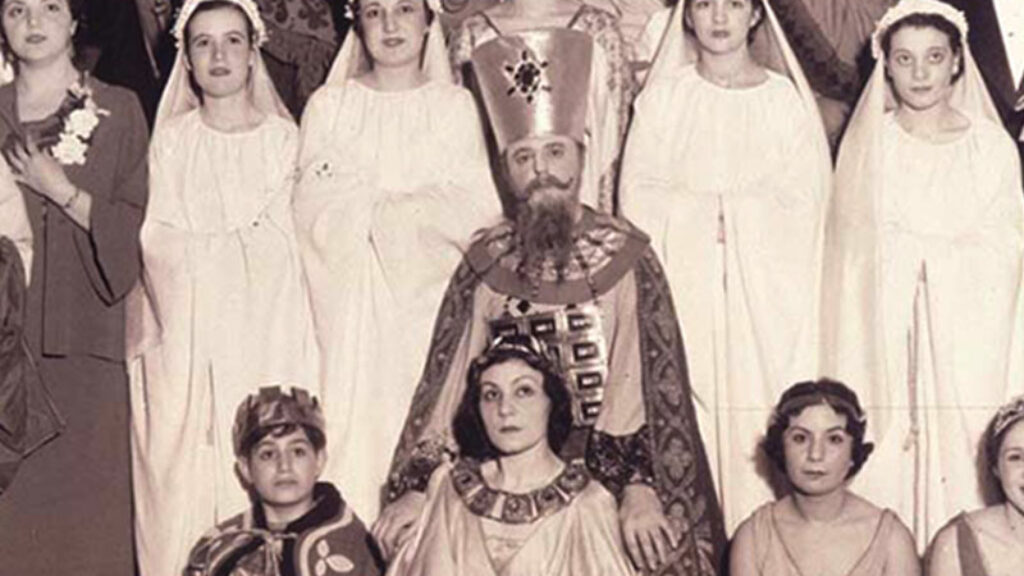
All-American Esther
Stuart Halpern’s anthology Esther in America tells the story of the surprising uses to which the story of Purim has been put in American history.
gershon hepner
ADAM, NARCISSUS AND ARISTOPHANES
Unlike Narcissus, who, we’re told by Ovid, wished to be divided
so his desire for himself could be fulfilled,
Adam, says the Bible, was divided after God decided
his seed should someone not himself be spilled.
Narcissus’s desire ended in disaster when he drowned,
enamored of the way his image was reflected,
a problem that despite God’s best intention sometimes may be found
in narcissists whom loving never has bisected.
First Woman, God made for First Man to cure his loneliness,
ensured that that he no longer would be odd,
deprived of singularity, his onlyness,
one cause of oddness like the Jews’ one God.
God’s gift to the First Man primary cause
of first occurrence of what Aristophanes
did not record, how violation of God’s laws
can cause painful rebukes, divine tell-offanies,